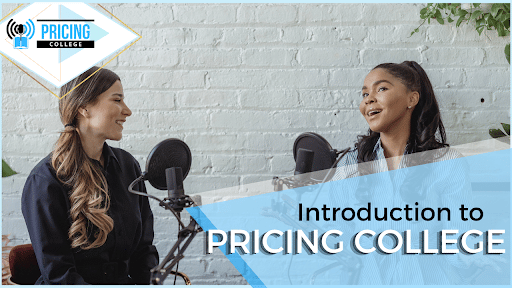
You Ever Meet Someone Who just has to have a Discount? 🏷 Podcast Ep. 48
In this episode of Pricing College – we talk about what to do when someone just has to have a discount.
We love not discounting – but sometimes you have to recognise that their are dedicates hagglers out there – the type who enjoys getting 1% off on shopping at the local market.
You know the type!
Listen on Apple Podcasts Listen on Spotify Listen on Google Podcasts Listen on Stitcher Listen on Amazon Music
TIME-STAMPED SHOW NOTES
[00:00] Introduction
[00:40] A given discount makes someone just has to have a discount feel better physiologically, emotionally, and intellectually
[01:34] How can a segmentation helps in giving discounts to the customers
[02:57] Sales needs to be aware that psychologically some customer wants to have a discount
[04:46] Discount oftentimes is an issue between sales and pricing department
[05:55] What is price waterfall?
[07:08] Aidan explain that it’s not all about the products different factors such as customer relationship is also a factor in selling or giving a discount
What to do when someone just has to have a discount?
In today’s episode, we want to cover…
- What do you do when you’re selling to somebody, a person who just insists on getting a discount?
- Who will not sign on the dotted line if they are not given a discount or less price?
According to Cialdini in the psychology of selling, he says that people feel better when they get some kind of compensation discount after a negotiation.
So there’s rule of thumb he’s saying whenever anyone does price negotiation at the back of their mind. What’s going to make them feel better physiologically, emotionally, and intellectually is if the seller offers them a discount. It doesn’t have to be a huge discount. But people want to feel that they’ve got something in this negotiation that they haven’t been had in some way. So that’s an important concept.
Now, the question we want to pose is…
- Should we factor that into the price?
- And how can we do that?
I’ve enrolled in the past, I’ve met people, and it’s just who they are, it’s their self-identity.
In the same way, there are people who self identify as salespeople. And there are people who self identify as bargain hunters and negotiators. They will haggle for anything. They’ll go to the local market and they’ll haggle over 1 or 2 cents. It’s almost the fun for them is in the haggling.
To be honest, at pricing college were also the view that you should try not to give discounts. And shouldn’t discount a list price. Because really what you’re doing is you’re destroying your margin. But there has to be a time when you recognise certain people will not buy from you if they won’t get that discount.
How can segmentation help in giving offers to someone who just has to have a discount?
And I suppose in this context really what you want to do is segment the market. Don’t give that discount to everybody. Make a decision that if you’re willing to offer a slight discount or whatever discount is required. I’d also say in this context, a small discount can often be as good as a big discount to people.
It’s just the fact that they get a discount is all that matters. Because often what they’re seeking is not the monetary value but just the psychological win. They can put that flag up and say they achieve victory in this negotiation.
How do you set about segmenting that customer from 99% of all the people who don’t? And, how much discount to give?
Because often the prices are optimising the price and looking at segmentation willingness to pay. But often the discount mechanisms and bonds are a little bit like an afterthought. Almost based on just literally volume and quantity. It’s not based on that emotional response.
People have to price negotiation and that rule needs some kind of compensation and discount like they’re driven to do it. There’s like psychological or biological dopamine hit when they get that discount. And as Aidan says, it doesn’t have to be big.
So, from a pricing perspective, we spend a lot of time looking at that price point but not factoring in that need for a discount.
And, often just putting a sort of a very crude three-level discount.
Often starting from that 10% and then quite harsh restrictions thereafter. What we find even is that salespeople on the ground who’ve sold to customers know that people ask for discounts quite a lot.
And maybe they don’t know why that person psychologically wants that discount but they know that they do it on a behavioural level. So they instantly, rather than just give like 5% off they go to the max and they give that 10% off.
That’s not a good practice. So I think what I’m trying to say here is that there has to be some greater awareness on the need for a discount on the consumer and customer perspective because it happens in B2B as well.
People just need that discount and also what we’re going to do is prices about it, and the guidance and the floors and fences around those discounts. So sales know what they’re going to do in response.
Traditionally, this is one of the big issues or cruxes or problems between the pricing departments and sales departments.
The sales departments are having that conversation, they’re speaking to the purchaser or the customer. It could be an individual, it could be a company and it could be a procurement person. And oftentimes pricing is sitting behind a desk or in head office or somewhere else.
There’s that view that maybe pricing doesn’t get that human interaction.
There could be a personal relationship over years between the seller and the buyer. It could be a long term account management aspect. If you’re a B2B salesperson or any salesperson and you’re driving out to their location if this person’s haggler they’re going to want to haggle all day.
Let’s be simple about it. If you’re selling a car and you know the person you’re going to sell it to want to haggle. If you want to sell a car for 1000 bucks. Maybe it’s not silly to quote an initial price above 1000 bucks to give you that haggle room we’ll call it. To give the person the price that they are willing to pay. And also the little victory that they want.

I think it’s important to factor all of this in the price waterfall.
Often you don’t see it’s just like as a discount. But there’s no explanation for it, it’s just all promotional discounts whatever. But that extra insight into that price waterfall helped. Because, ultimately, if you don’t acknowledge the fact that people want a discount. It’s going to come out of your margin anyway, the pocket price.
So, I think it’s important to factor in. So textbook wise like I can hear prices saying, never give discounts. If you’re going to reduce the price. Let’s look at negotiating the value trading, value price and all of that stuff for sure that’s textbook. You shouldn’t necessarily resort to giving a discount.
But have we addressed the real problem or issue here is that people like discounts. Why wouldn’t we want to please our customers by providing some kind of discount? If we had more control of our discounts based on more research into how people respond to them. And why they required them. Then, I think we can optimise our discounts and drive more revenue as well.
Bottomline: Discipline and flexibility on your pricing structure will give you knowledge of what to do when someone just has to have a discount
Here at pricing college and Taylor Wells, we always talk about is not just the product, it’s the periphery. It’s the other stuff that goes with it like the customer services, the experiences, the shop, the after-sales care. To some extent, the actual selling process is one of those things too.
If you’re friendly with a salesperson that can be of value to it as well. If you know a person over the years, that’d be an experience. Like a lot of people like going to traditional markets. They’re like going for the bows, the colours, the experience, the haggle. That aspect is very different to the modern sanitised supermarket experience.
People put a value on different things.
What you want to be doing is understanding why and segmenting your market. So that you’re only giving discounts to people where it’s necessary. And understanding how much of a discount is being given.
Have some guidance. Trust your sales team a bit and don’t dictate to them what to do. Have that guidance that they know there’s a little bit of wiggle room when required but only in those instances. I think, otherwise as long as the discount is not huge. And if it gets you across the line.
Ask yourself the question… “are you happy to get that sale in at a slightly lower price?”
And if you are then there’s no negative from it. The other thing is this applies in any aspect of life. If you are saying no to people, it’s a monumental final no. There’s no room for negotiation, no wiggle room and if you do that it’ll quite often people backs up.
It could ruin a relationship slightly. And from trying to argue and maintain that 1% of margin could end up getting no sales at all.
I completely agree,I think you’ve kept it off well.
I think saying no is very final and people remember that “no”.
They won’t remember all the services that you provided before at reasonable prices. Or the discounts you offered in the past, they’ll just remember the last thing. That’s the way human minds work. They remember the beginning and the end not so much the journey.
So yeah, just bear in mind the realities of how people like to buy. It’s not always as sanitised as we liked to think. Applying a lot of logic to pricing is critical. But we’ve got to address how people respond to price and that’s often not always irrational.
People do buy emotionally as well as cognitively and both can be easily distorted. But having that more discipline around discounts and more flexibility around your pricing structure. If you know your ranges and you know your price bands you can do more creative discounting without necessarily giving all your offer away for free. So it’s a win-win for everyone.
Many companies and people talk about the personalised service that we know our customers.
If you know them, show them that you know it and put it into play. At the end of the day, it’s an asset to you. This should not be a downside for you or negative this should be an asset.
If you have customers you know well, who you understand. You’re much more likely to sell to them on an ongoing basis. The lifetime value of that customer is likely much higher. And you might even enjoy your job a bit more. Let machines do what machines do well, let people do what people do well.
Empower your sales staff with good guidance and good structures. So that they know they’re doing the right thing and they know where they can go and what they can do.

For a comprehensive view on building a great pricing team to prevent loss in revenue,
Download a complimentary whitepaper on How to Build Hiring Capability To Get The Best Pricing Team
Related Posts
Leave a Reply Cancel reply
Categories
- marketing strategy (26)
- Organisational Design (14)
- Podcast (114)
- Pricing Capability (87)
- Pricing Career Advice (10)
- Pricing Recruitment (19)
- Pricing Strategy (291)
- Pricing Team Skills (13)
- Pricing Teams & Culture (25)
- Pricing Transformation (47)
- Revenue Model (25)
- Sales Effectiveness (27)
- Talent Management (7)
- Technical Pricing Skills (35)





